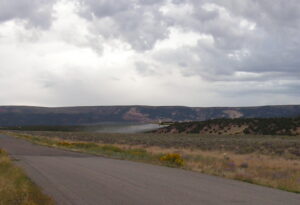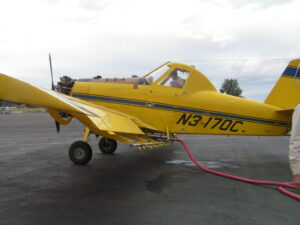Description
Fixed-wing aircraft with spray booms mounted below the lower wing have been used effectively to apply herbicidal sprays over extensive areas to control brush and weeds since the 1950s. Today’s spray planes are designed specifically for aerial application of liquid and dry materials and meet strict safety requirements. They use radial-piston or turbine engines with a range in horsepower from 600 to 1300. Current spray tank capacities vary from 400 to 800 gallons while older aircraft had spray tank capacities of 300 gallons or less. Airspeed can vary from 100 to 160 mph but is about 120 mph for brush and weed spraying. Spray boom length should not be more than three-fourths the length of the wingspan because the turbulent wingtip vortices cause drift. Spray pumps must have positive shut-off valves and nozzles must have check-valves to prevent continuous spraying or leakage over off-target areas. Hydraulic spray nozzles are the predominate type used on aircraft and many styles and sizes are available. GPS/GIS systems are helpful for precision applications.
Application
Spraying equipment and techniques are designed to minimize drift while applying spray droplets of efficacious size to the plant canopy. Aerial sprays are normally applied when wind speed is between 2 and 10 mph and air temperatures are not above 90 °F. Spraying should not be conducted in no-wind conditions because of inversions (warm air over cold air) or potential shifts in wind direction. Federal (EPA) and state regulatory agencies have strict regulations for aerial spraying, and applications must follow the specifications on the chemical’s Product Label. Fixed-wing aircraft are cost effective because they can spray large areas quickly and effectively. They have larger payload capacities and greater airspeeds than helicopters. Airstrips are required for landing, servicing, and takeoff. Excessive ferrying distances are wasteful and costly. GPS/GIS units negate the use of flagmen and can record flight patterns. Fixed-wing planes are not suited for spraying highly irregular shaped sites or mountainous areas.
References / Additional Information
Stevens, R.; Monsen, S.B. 2004. Chapter 9. Mechanical plant control. In: Monsen, S.B.; Stevens, R.; Shaw, N.L., comps. Restoring western ranges and wildlands, vol. 1. Gen. Tech. Rep. RMRS-GTR-136-vol-1. Fort Collins, CO: U.S. Department of Agriculture, Forest Service, Rocky Mountain Research Station. p. 65-88.



